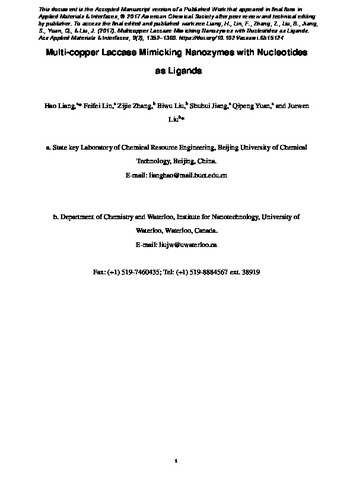| dc.contributor.author | Liang, Hao | |
| dc.contributor.author | Lin, Feifei | |
| dc.contributor.author | Zhang, Zijie | |
| dc.contributor.author | Liu, Biwu | |
| dc.contributor.author | Jiang, Shuhui | |
| dc.contributor.author | Yuan, Qipeng | |
| dc.contributor.author | Liu, Juewen | |
| dc.date.accessioned | 2017-04-28 16:11:53 (GMT) | |
| dc.date.available | 2017-04-28 16:11:53 (GMT) | |
| dc.date.issued | 2017-01-18 | |
| dc.identifier.uri | http://dx.doi.org/10.1021/acsami.6b15124 | |
| dc.identifier.uri | http://hdl.handle.net/10012/11781 | |
| dc.description | This document is the Accepted Manuscript version of a Published Work that appeared in final form in Applied Materials & Interfaces, © 2017 American Chemical Society after peer review and technical editing by publisher. To access the final edited and published work see Liang, H., Lin, F., Zhang, Z., Liu, B., Jiang, S., Yuan, Q., & Liu, J. (2017). Multicopper Laccase Mimicking Nanozymes with Nucleotides as Ligands. Acs Applied Materials & Interfaces, 9(2), 1352–1360. https://doi.org/10.1021/acsami.6b15124 | en |
| dc.description.abstract | Using nanomaterials to achieve functional enzyme mimics (nanozymes) is attractive for both applied and fundamental research. Laccases are multicopper oxidases highly important for biotechnology and environmental remediation. In this work, we report an exceptionally simple yet functional laccase mimic based on guanosine monophosphate (GMP) coordinated copper. It forms an amorphous metal organic framework (MOP) material. The ratio of copper and GMP is 3:4 as determined by isothermal titration calorimetry. It has excellent laccase-like activity and converts a diverse range of phenol containing substrates such as hydroquinone, naphthol, catechol and epinephrine. Comparative work shows that the activity is originated from guanosine coordination instead of phosphate binding in GMP. Cu2+ is required and cannot be substituted by other metal ions. At the same mass concentration, the Cu/GMP nanozyme has a higher V-max and similar K-m compared to the protein laccase. To achieve the same catalytic efficiency, the cost of the Gu/GMP is similar to 2400-fold lower than that of laccase. The Cu/GMP is much more stable at extreme pH, high salt, high temperature and for long-term storage. This is one of the first laccase-mimicking nanozymes, which will find important applications in analytical chemistry, environmental protection, and biotechnology. | en |
| dc.description.sponsorship | Beijing Natural Science Foundation [2162030]; Fundamental Research Funds for the Central Universities [YS1407]; China Scholarship Council; 111 project; Natural Sciences and Engineering Research Council of Canada (NSERC) | en |
| dc.language.iso | en | en |
| dc.publisher | American Chemical Society | en |
| dc.subject | Metal-Organic Frameworks | en |
| dc.subject | Biocoordination Polymers | en |
| dc.subject | Enzymes | en |
| dc.subject | Nanoparticles | en |
| dc.subject | Complexes | en |
| dc.subject | Molecules | en |
| dc.subject | Oxidation | en |
| dc.subject | Mechanism | en |
| dc.subject | Chirality | en |
| dc.subject | Glucose | en |
| dc.title | Multicopper Laccase Mimicking Nanozymes with Nucleotides as Ligands | en |
| dc.type | Article | en |
| dcterms.bibliographicCitation | Liang, H., Lin, F., Zhang, Z., Liu, B., Jiang, S., Yuan, Q., & Liu, J. (2017). Multicopper Laccase Mimicking Nanozymes with Nucleotides as Ligands. Acs Applied Materials & Interfaces, 9(2), 1352–1360. https://doi.org/10.1021/acsami.6b15124 | en |
| uws.contributor.affiliation1 | Faculty of Science | en |
| uws.contributor.affiliation2 | Chemistry | en |
| uws.contributor.affiliation3 | Waterloo Institute for Nanotechnology (WIN) | en |
| uws.typeOfResource | Text | en |
| uws.peerReviewStatus | Reviewed | en |
| uws.scholarLevel | Faculty | en |

